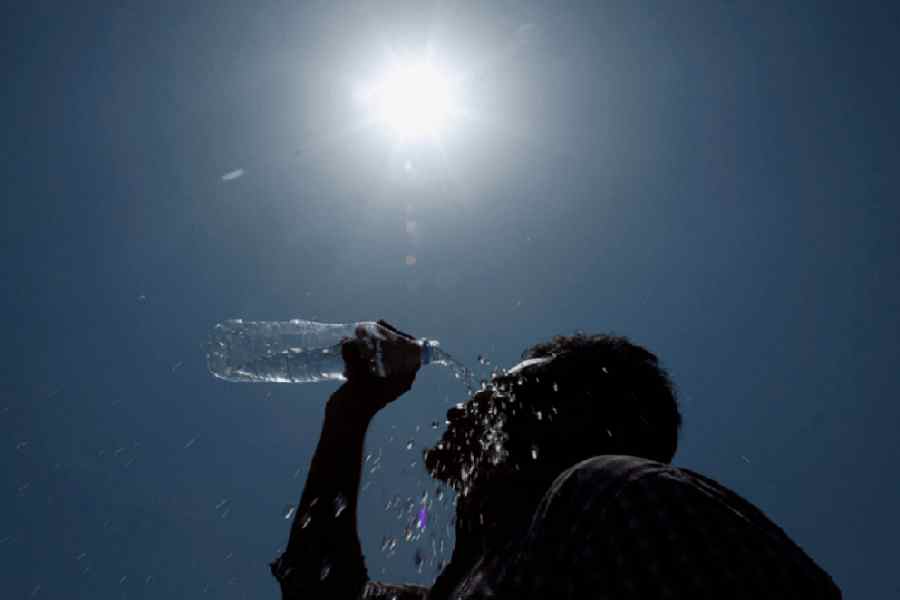The mercury soared to 43 degrees on Tuesday, something that most Kolkatans have never seen happening in April, as the ongoing heatwave tightened its grip on the city.
Tuesday was the hottest April day in 70 years. April 25, 1954, was hotter with a maximum temperature of 43.3 degrees Celsius.
The city has seen hotter days but none in 45 years (see chart). On June 5, 1979, the maximum temperature was 43.2 degrees Celsius. May 21, 2002, was as hot as Tuesday.
Churu in Rajasthan, arguably the hottest place in India — where in May 2020, the Celsius rose to a record 50 degrees, according to news reports — saw a maximum of 37.2 degrees on Tuesday. It was almost five degrees below normal.
In Kolkata, the deviation was almost eight notches above normal. That broadly means Kolkata’s weather is as hot as Churu’s normal summer.
A Met bulletin on Tuesday extended the tenure of the ongoing heatwave till May 4. The forecast also offered a sliver of hope. “Rain/thundershower likely on May 6,” it said.
There is a semblance of southerly winds from the Bay after sundown but they are active only near the surface, up to five to seven metres from the ground, a Met official said.
These southerly winds will make the evenings partly cloudy. They might also trigger localised and isolated thunderstorms in some coastal areas like East Midnapore and South 24-Parganas, said the official. But there is little chance of uniform thunderstorm in south Bengal over the next four to five days, he said.
The day temperature in the city jumped from 41.7 degrees on Monday to 43 on Tuesday.
A Met official had on Monday said the maximum temperature in Kolkata was likely to be in the range of 40 to 42 degrees over the coming days.
“Any forecast comes with an error margin of at least a degree,” said H.R. Biswas, head of the weather section at the Regional Meteorological Centre, Kolkata. The official forecast of the maximum on Wednesday is 42 degrees.
“No large change in day temperature during next 4-5 days over South Bengal...,” said the heatwave bulletin.
But Kolkatans would not be so sure, going by the ruthlessness of the sun.
Around 2.45pm on Tuesday, a traffic cop was probably the only person at the crossing of Mayo Road and Dufferin Road. He was sitting under a shed at a traffic kiosk, a jar of water kept behind him.
The temperature was 43 degrees and the RealFeel around 48 degrees, according to a private forecasting agency.
Around 3.15pm, 10km away, two women walked towards the Sports Authority of India complex near Salt Lake Stadium. One of them used her dupatta to cover them both.
Usually, the heat loses some steam as the afternoon gives way to the evening. But even around 5pm on Tuesday, outdoor activity was a challenge because of the hot air.
Social media was abuzz with memes. “Nor’westers should be part of history and not geography books,” read a post.
April has not seen a single squall in Kolkata. Only April 7 saw isolated drizzles.
The hot and dry westerly and northwesterly winds are still dominating the lower levels of the atmosphere, said the heatwave bulletin.
The lower levels of the atmosphere, in Met parlance, refer to an area that stretches between 1km and 1.5km from the surface of the earth.
“For thunderstorms in south Bengal, moisture-laden southerly winds from the Bay need to reclaim this zone. That is unlikely before the start of next week,” said Biswas.
The daily weather report said: “A cyclonic circulation lies over northeast Bangladesh and extends upto 1.5 km above mean sea level. A trough now runs from north Bihar to Manipur across sub-Himalayan West Bengal, cyclonic circulation over northeast Bangladesh and south Assam at 0.9km above mean sea level.”
The trough, now running from west to east, is tipped to change its position. “By May 5, it is expected to become a north-south trough, running from Jharkhand to Chhattisgarh. Then, the system will be an ally for the moisture and heat to trigger thunderstorms in south Bengal, including Kolkata,” it said.
